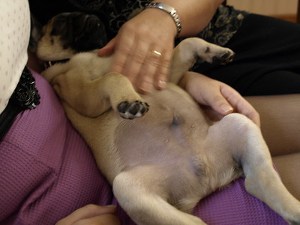
Having a new puppy changes your life quite a bit, and at the same time as it can result in a lot of fun and happiness it can also result in a lot of stress and worry.
The stress and worry part can sometimes even overwhelm the happiness, particularly if there appears to be something wrong with your newest family member.
So what if you notice lumps on your puppy’s belly? Is it cause for concern, or is it perfectly normal? We’ll be discussing all the reasons why this might happen throughout this article, and hopefully by the end you’ll have your answer and be able to get back to having fun with your pup in no time.
Umbilical Hernia
If the lump on your dog’s belly is swelling that is visible right below their navel then it may be a sign of an umbilical hernia. In this case, the swelling might become more apparent as the puppy becomes active. So activities such as barking, crying, straining, or even standing could cause it to protrude further.
An umbilical hernia can happen when the umbilical ring doesn’t fully close as it’s supposed to after birth. This will result in abdominal lining and fat being pushed through the opening forming a hernia. In some severe and rare cases parts of the intestines could slip through the hole, and if they become strangulated it could cause the tissue to die. This would count as a medical emergency.
Hiatal Hernia
Dogs can also have hiatal hernias, sometimes caused by trauma, this condition is normally the result of a birth defect. With a hiatal hernia, the bulge may be intermittent and not clearly visible at all times. When the hernia can be seen, it would be located at the base of the diaphragm. If your puppy vomits when it becomes excited or during playtime/other times of movement then this can be another indicator that it could have a hiatal hernia.
Abscess
The lump you see on your puppy’s belly could also be an abscess. Signs to look out for that could point towards the bump being an abscess would be a soft spot of swelling, a sore that is draining pus, and/or an area that is hot to the touch and causes discomfort to your pup. Abscesses form when the body is trying to fight an infection caused by an injury of some kind (normally an injury that involves a break in the skin) with white blood cells and other blood components, referred to collectively as pus, and that pus builds up within the tissue therefore creating a painful swelling. Abscesses can also occur internally in some cases.
Bites
Another reason there may be lumps on your puppy is that it’s been bitten by something whether that be another animal, insects, or even itself. In this case it’s basically the same as if us humans get bitten by something, there will be a bump, lump, redness, or some kind of visual sign that it happened. Depending on what did bite your dog, the lump might vary visually. Not all bites will look the same, so it’s important to pay attention to exactly what the lumps look like.
Stings
Similarly the lump on your puppy’s belly could be caused by an insect sting. In the place where the sting happened there will be a bump as a visual indicator and depending on how your puppy reacts to this sting then it could be very swollen and irritated. Additionally, there may be one or more of these depending on how many times your puppy was stung, and the same thing is true for the bites that were just mentioned.
Lipoma
Lipoma could also be to blame for lumps on your dog, although this issue is more commonly seen in older dogs than younger ones. But it is more likely to happen at any age if your dog is overweight since lipoma, also known as fatty tumors, form from fat cells. Although these tumors could be found anywhere, they are typically more likely to appear on a dog’s stomach or chest. These lumps are likely to be pretty circular in their shape, and only sometimes have irregular borders. They are also likely to be squishy, but they can be firm in some cases and depending on how attached they are to the tissue surrounding them they may or may not move around. It is important to note that these tumors are benign.
Histiocytoma
And histiocytoma is another benign tumor that could be plaguing your pet. Histiocytoma refers to a small, pink, and domed skin growth on your pet. They take about one to four weeks to fully sprout and might take a while to notice since they don’t typically come along with many symptoms. It is more common for them to appear on a dog’s head and ears but they can also appear anywhere else, including your puppy’s stomach. And unlike lipoma this benign tumor is actually more commonly seen in dog’s below three years of age so it is more likely to be a problem for puppies.
Perianal Adenoma
Yet another benign tumor is the next reason why there may be lumps on your puppy’s stomach. To break this name down, since it seems so scary, perianal refers to the spot on your dog’s body where these tumors lie which is on and around the anus area. This area can also extend towards the belly. And adenomas means benign so a benign tumor around the perianal area is perianal adenoma. Hormones, specifically testosterone and estrogen, are some of the biggest factors behind this type of tumor and for this reason these tumors are more likely to happen in
unneutered male dogs and spayed female dogs. These lumps will be small, hairless, round, and pink. They sometimes break open which can cause irritation and you may notice your dog licking the spot frequently.
Hives
Your puppy could also be suffering from hives if it has been exposed to an allergen and is having an allergic reaction. These raised, circular lumps could be present in other areas of the body (especially the face) and might be accompanied by swelling around the muzzle and the eyes among other symptoms. An allergic reaction could obviously be caused by anything but some of the common causes are actually some of the other reasons for lumps on your dog’s belly, namely insect stings and bites.
Pyoderma
Pyoderma, sometimes referred to as impetigo, is a bacterial skin infection that is our final reason for why you might be seeing lumps on your puppy’s stomach. This condition can be caused by many things including the skin being broken, the immune system being suppressed, or other reasons. The lumps that go along with these issues are going to look a lot like a pimple on a human would. You should also note that puppy proderma is fairly common, and develops mostly in areas without as much hair.
How can these things be treated?
If you notice lumps on your puppy’s belly then the best thing to do is take your pet to the vet, the vet can identify which of these issues is causing the lumps and they’ll know best what to do for each of these problems. Lipoma for instance typically only requires monitoring unless they get large enough that they need to be surgically removed, whereas pyoderma would need antibiotics and possibly some medicated spray or shampoo. Hives caused by an allergy would mean that the allergy needs to be identified and eliminated from the dog’s life, which the vet could help with. And hernias may need a surgical fix which your veterinarian can perform.
In conclusion….
Although noticing lumps on your puppy’s stomach can be terrifying and a huge source of stress, most of the time the cause behind it is perfectly manageable and not dangerous especially if it’s caught early since that makes practically anything easier to treat. If you have noticed lumps on your pup’s belly then pat yourself on the back for being observant enough to notice and take your dog to the vet. At the vet they can confirm a diagnosis and tell you exactly how to proceed to get your newest family member back to full health in no time. And always remember that puppies are a good thing in spite of the stress they can sometimes cause and bring way more happiness into the home than worry.






